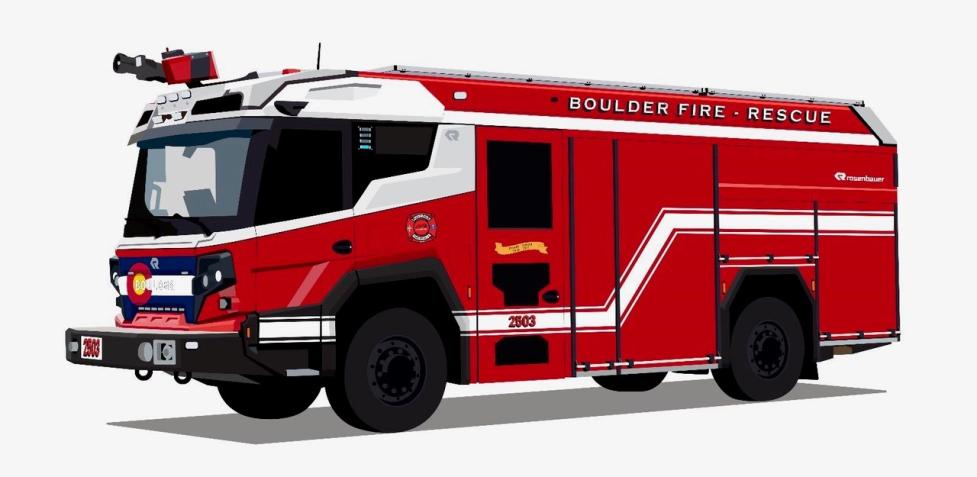Find Press Releases from the City of Boulder about the Rosenbauer RTX purchases in our newsroom.
More in-depth information about the Rosenbauer RTX on their website.

Find Press Releases from the City of Boulder about the Rosenbauer RTX purchases in our newsroom.
More in-depth information about the Rosenbauer RTX on their website.
“The amazing thing about this engine is that it functions more effectively than our legacy engines because of the built in option to power the engine in two ways: electric and diesel.”
The engine has batteries instead of a diesel engine that power both axels as well as the water pump. The drivetrain is 100% electric driven. The pump works in conjunction with the diesel motor and battery power through a transfer case. At full pump capacity the RTX manages the power sent to the pump to ensure full pump operation. There is a diesel engine auxiliary power backup system that automatically activates when the battery power goes below 20%. This is why is it is considered a "Range Extended Electric Vehicle" (REEV). That diesel system's sole purpose is to charge the batteries that run the all-electric drivetrain and pump for the duration of the call. It is estimated that over 95% of our calls will be completed prior to the batteries going below 20%.
You can find a comprehensive explanation of the Rosenbauer RTX, along with additional data and estimates, on the website.
Here are some highlights:
The energy backup system, designed for flexibility and redundancy, plays a crucial role. Not only can it recharge the batteries, but it can also take over pumping operations during extended incidents, ensuring a reliable and resilient firefighting solution.
The Rosenbauer RTX engines:
With the Rosenbauer RTX engines, Boulder Fire-Rescue crews:
We plan to house one Rosenbauer RTX engine at Station 1 and one at our new Station 3, which is currently under construction (more on information about the Station 3 Project).
As a new build for Boulder, Station 3 is being built with the city's climate initiatives in mind. Both Stations 1 and 3 are/will be fitted with photovoltaic power (solar panels). The apparatus bays will be outfitted with electrical fire apparatus charging capabilities.
All of our engines are stored inside at our various stations, where they are plugged in in order to maintain electrical equipment charging. This operational practice is already in place and will remain the same for the electric engine as well.
The Rosenbauer RTX was designed with firefighter occupational safety in mind. This build places emphasis on firefighter access and tool placement, so we hope it will have a positive impact on reducing the occupational load on our firefighters.
The estimated operational capacity, including mileage range and pump operation, is expected to be comparable to our current fire engines. We will begin gathering data on how the RTX does in Boulder specifically once we recieve this engine and put it into service.
While all of our fire engines are designed to best meet the needs of our community, this fire engine, in addition to meeting the fire service requirements of all of our current engines, can also provide the following benefits:
We believe in taking care of our community and our firefighters. The new Rosenbauer RTX presents us with an opportunity to do both of those things. All fire engines are designed to serve and protect their communities.
These engines will also enable us to better serve and protect our firefighters. We're invested in progress for our community and our staff; this fire engine will provide a safer occupational space for all of our firefighters and benefits to the community. We are excited to be the first city in the United States with two RTX engines.
Each Rosenbauer RTX engine is estimated to cost around $1.8 million dollars. In comparison, recent conversations with diesel engine suppliers indicate that all engines could soon cost over 1 million dollars, regardless of them being diesel or electric powered.
We also anticipate a decrease in costs for fuel and service needs. By replacing a diesel engine and pump system and using electric, the Rosenbauer RTX is expected to require less service, maintenance and parts. Over the past few years, it has become increasingly difficult and expensive to service our diesel engines.
The Rosenbauer RTX engines will also come with a five year parts, labor and service agreement, which is four years more than any of our current apparatus mechanical warranties.
“The RTX is equipped with additional features that set it apart and prove invaluable for Boulder firefighters in optimizing their efficiency. Among its distinctive attributes are state-of-the-art ergonomic technologies that prioritize firefighter health and safety. Notably, the RTX includes an adjustable suspension, allowing it to raise and lower its ride heights based on the terrain.”